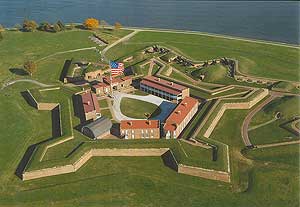| Pratt Street Riot | Baltimore Bastille | Habeas Corpus | Coast Guard | Garrison Flag | Timeline | All Photos |
Fort McHenry
"O say can you see, by the dawn’s early light," a large red, white and blue banner? "Whose broad stripes and bright stars . . . were so gallantly streaming!" over the star-shaped Fort McHenry during the Battle of Baltimore, September 13-14, 1814. The valiant defense of the fort by 1,000 dedicated Americans inspired Francis Scott Key to write "The Star-Spangled Banner."
Fort McHenry's history began 1776 during the Revolutionary War. The people of Baltimore feared an attack by the British, and wanted to build a fort for protection. Anticipating an attack at any time, a fort of earthen mounds was constructed quickly. Originally, it was called Fort Whetstone, because of its location on Whetstone Point.
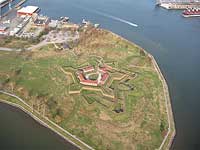 Whetstone Point was an excellent location for a fort for two reasons.
It was located far enough from Baltimore to provide protection without
endangering the city, and the area was a peninsula - a body of land
surrounded on three sides by water. Constructing the fort on this site
meant that the enemy ships, sailing into Baltimore would have to pass
the fort first.
Whetstone Point was an excellent location for a fort for two reasons.
It was located far enough from Baltimore to provide protection without
endangering the city, and the area was a peninsula - a body of land
surrounded on three sides by water. Constructing the fort on this site
meant that the enemy ships, sailing into Baltimore would have to pass
the fort first.
The Revolutionary War ended without an attack on Baltimore, but improvements to the fort continued. In 1798, a French engineer was directed by the Secretary of War to draw plans for a new fort on Whetstone Point. These plans were expensive, and it was difficult for the people of Baltimore to raise money for construction. However, James McHenry, a well-known politician, was instrumental in raising funds for the new fort. The fort was renamed "Fort McHenry" in his honor.

|
| Fort McHenry with cannons. |
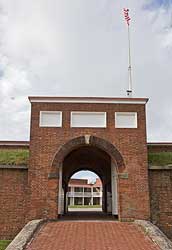
|
| Entry to Fort McHenry. |
During the 1830's, major improvements were made to the fort. Second stories were added to the barracks, and two new guardhouses were built on each side of the Sally Port, to replace the two earlier ones.
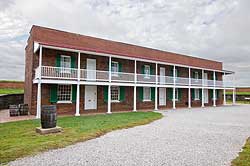
|
| Fort McHenry Barracks. |
Meanwhile, France and Great Britain who were at war with one another, had set up economic blockades to keep each other from getting important supplies. As a neutral carrier for both countries, America's merchant ships sometimes were caught in the blockades, and all of their goods would be confiscated by one or the other of the two countries. In addition, the British frequently captured American seamen and forced them to serve in the Royal Navy. Also, the Americans thought the British were encouraging the Indians in the West to attack frontier settlements. Finally, the Americans became so angry with the way they were being treated that the United States declared war on Great Britain in June 1812 to protect "free trade and sailors' rights," and American rights on land.
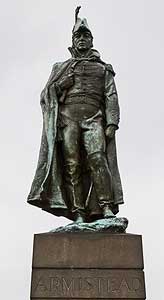
|
| Major George Armistead.. |
Fort McHenry became famous when the British tried to attack Baltimore during the War of 1812. When the bombardment began on September 13, 1814, there were 1,000 soldiers defending the fort. Some were federal soldiers who were stationed at Fort McHenry all the time. Many were volunteers from the city of Baltimore. Their commanding officer was Major George Armistead. For 25 hours, the British bombarded Fort McHenry, but the fort's artillery fire kept the British away. Baltimore was saved.
In the 1860's the United States was torn apart by the Civil War. Union troops were stationed at Fort McHenry to help keep Baltimore out of the hands of those who would have Maryland join the southern cause. The fort's guns were turned toward the city. Fort McHenry was used as a prison where political prisoners suspected of being Confederate sympathizers were held, often without trial. Many Confederate soldiers were imprisoned at the fort as well.
In 1917 during the first World War, General Hospital No. 2 was established at Fort McHenry by the War Department. It was the largest military ospital in the country with over 100 temporary buildings to accommodate wounded American soldiers returning from the war in Europe.
When the war ended, the need for the hospital slowly diminished, and in 1825 the temporary buildings were torn down. Fort McHenry became a national park which today is administered by the National Park Service as the country's only National Monument and Historic Shrine.
